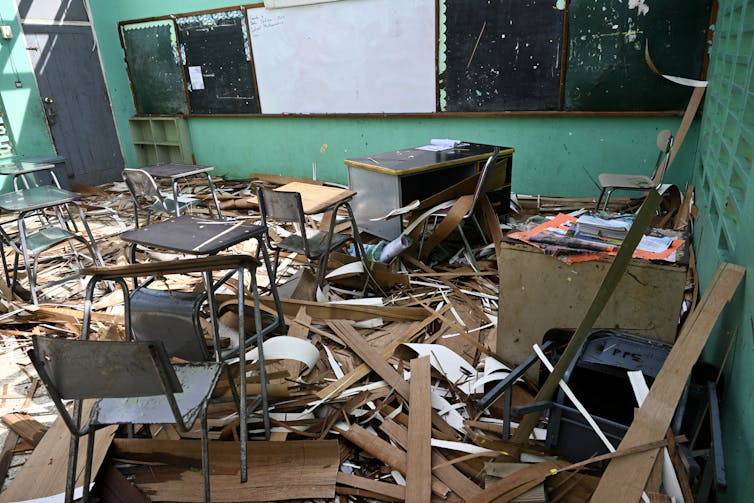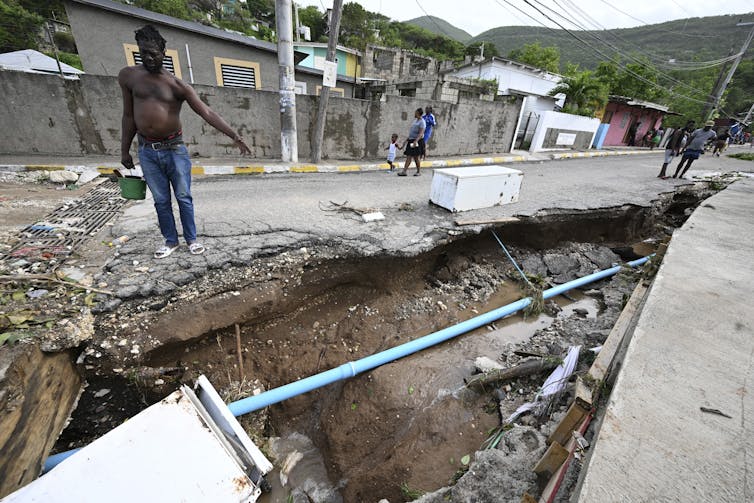Source: The Conversation – UK – By Laura Smith, PhD Researcher and Graduate Teaching Fellow, University of Liverpool
In her 2022 novel Trespasses, Louise Kennedy captures the emotional turmoil of an intimate relationship between Cushla, a young Catholic woman, and Michael, an older married Protestant man during the Troubles in Northern Ireland. Their love is difficult, not just because Michael is married but also because it is seen as a “mixed relationship” within Northern Irish society.
The Troubles was a period of violence stemming from a political divide over British rule, which lasted for about 30 years from the late 1960s to 1998. The fighting was between the Unionist/Loyalists who wanted Northern Ireland to remain part of the United Kingdom and the Nationalist/Republicans who sought a united Ireland. These groups were also split on religious lines with Unionist/Loyalists being mostly Protestant and Nationalist/Republicans mostly Catholic.
Channel 4’s new adaptation of Trespasses, starring Lola Petticrew, Tom Cullen and Gillian Anderson, is set in 1975, in the height of the Troubles. With the signing of the Good Friday Agreement in 1998, which brought an era of “peace” to Northern Ireland, you might assume the experiences of Cushla and Michael would no longer be common. However, my research shows that the story’s themes of forbidden love remain for women in “mixed” relationships today.
In Northern Ireland, many people still identify as either being Catholic, Nationalist and Republican or Protestant, Unionist and Loyalist, although there is an increase in people now choosing to identify as “neither”. However, key indicators of the degree of segregation in society still remain high.
The availability of integrated schools or provision of mixed-denomination social housing remains low, which means the opportunities to mix across these communities can be limited. There is also the continued presence of “peace walls”, physical barriers made of materials such as concrete, barbed wire or corrugated metal at interfaces between residential areas, which serve as a visual reminder of the violent conflict.
Endogamy, where couples marry someone from their own community, is still the single most powerful factor that bolsters the divisions between groups. Estimates suggest that approximately 20% of all relationships in Northern Ireland are mixed. Charities such as the Northern Ireland Mixed Marriage Association (NIMMA), which was founded in 1974, continues to support couples living with these undercurrents of institutionalised segregation. And for many couples, just like Cushla and Michael, crossing the religious and political divide still carries some emotional weight.
Everyday challenges
For Cushla, worrying about being seen in public with Michael is a recurring theme throughout their love story. Her inner monologue documents decisions she makes to counteract this fear of political violence, including avoiding driving through loyalist roads that border Michael’s area.
In my own research with women currently in mixed-denominational relationships in Northern Ireland, I found that echoes of Cushla’s fears persist. While none of my participants spoke about fear of physical violence, many spoke about ways they have learned to cope with subtle disapproval from neighbours and colleagues. Telling friends and family about their relationship also proved difficult for some women.
One participant spoke about how fear infiltrated into her parents’ concerns:
I knew my parents were uncomfortable with me going to a super Protestant area they’d heard bad things about. And then, I know that they were uncomfortable at the idea of me even being in a house with like a British soldier, they didn’t like that idea at all.
There was also a common thread of how women have to negotiate different expectations from families. This often emerged while organising weddings or raising children, and was a source of emotional discomfort.
While couples may feel invincible – just like Cushla and Michael did in their dangerous and passionate relationship, leading them to get complacent with their precautions – love isn’t always enough.
Everyday peace
As my ongoing research has shown, there can be a particular emotional burden that falls on these couples as they try to maintain harmony between two different identities. This burden often falls on the woman in the relationship, and is connected to other aspects of emotional and reproductive work that women may feel pressured by society to undertake.
My work focuses on how couples manage these relationships through practising what peace and conflict researchers call “everyday peace”. It refers to the ways in which ordinary people try to make their way with as much as ease as possible through in a deeply divided society. For people in mixed relationships, this can lead them to choose to stay silent, avoid contentious issues, or become ambiguous about their identity.
Ambiguity was most strongly demonstrated with reference to names. As Cushla refers to herself, Irish names become significant identifiers of being Catholic. We watch as she is tempted to give a fake name when she is stopped at a checkpoint by a Protestant soldier.
Some of my participants similarly ask their partners to refer to them by a different name while they’re at a pub in a new area. Another example given was using a nickname when getting parcels delivered to their house. These strategies emerge out of a genuine fear, or a self-acknowledged paranoia of what might happen if the wrong person finds out they are in a mixed relationship.
My research shows that being in a mixed relationship within a society trying to heal is still complicated. While it is certainly possible to have a successful mixed relationship in Northern Ireland today, some of the contentious aspects of Cushla and Michael’s relationship do still prevail.
This article features references to books that have been included for editorial reasons, and may contain links to bookshop.org. If you click on one of the links and go on to buy something from bookshop.org The Conversation UK may earn a commission.
Looking for something good? Cut through the noise with a carefully curated selection of the latest releases, live events and exhibitions, straight to your inbox every fortnight, on Fridays. Sign up here.
![]()
Laura Smith does not work for, consult, own shares in or receive funding from any company or organisation that would benefit from this article, and has disclosed no relevant affiliations beyond their academic appointment.
– ref. Trespasses: little has changed for couples dating across the religious and political divide in Northern Ireland – https://theconversation.com/trespasses-little-has-changed-for-couples-dating-across-the-religious-and-political-divide-in-northern-ireland-269550







